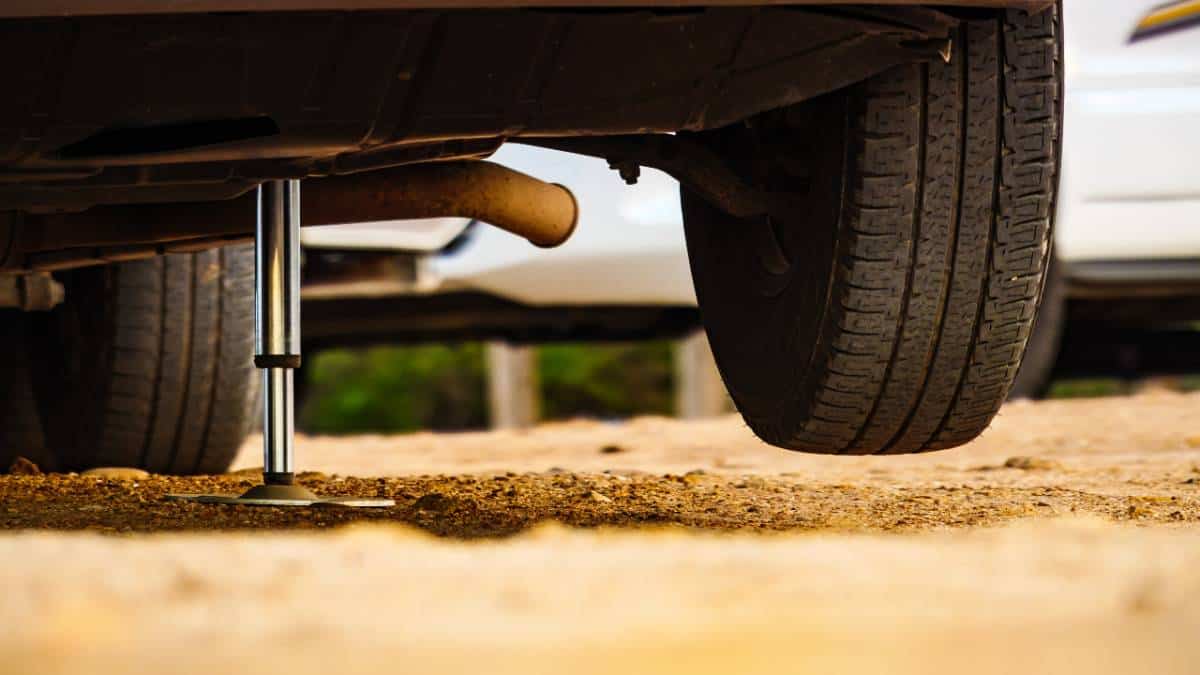While traditional RVers prepare their coaches for storage in the off-season, there’s a group that takes RV winter camping very seriously. As you’re driving by some of the best lakes in the midwest, you’ll see a small community of RVs set up on the lake with a festive atmosphere. If you pull over to investigate, you’ll find out it’s a collection of ice anglers in some of the best fish house RVs.
Ice shanties have come a long way since the early animal hide tents of the Native Americans. Join us as we explore how modern manufacturers have applied RV engineering to today’s aluminum fish houses. We’ll show you how ingrained they are with the best ice fishing lakes in Minnesota.
What is a Fish House RV?
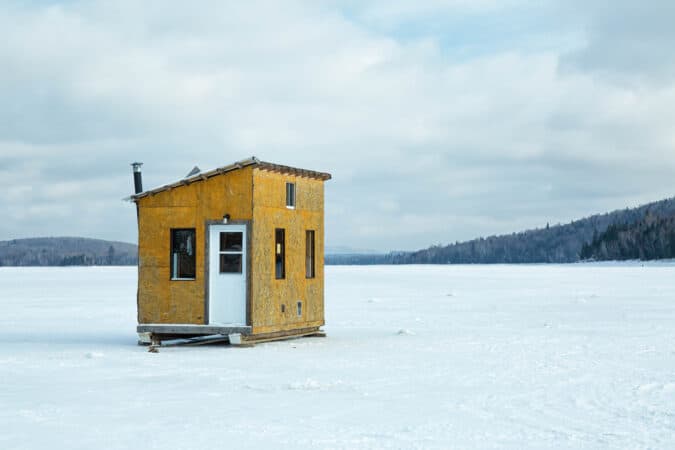
From Ice Shanty to Fish House RV
To survive the winter months over 2,000 years ago, the ancient Native American Nations were the first people to start ice fishing. Early fishers would use wooden lures shaped like small fish in holes made in a lake or river ice to spearfish. Anglers looking for a real challenge still try this “dark angling” technique today.
Early fish houses, known as ice shanties, were homemade structures built to be dragged or set up on frozen lakes to stay warm. As ice fishing became a popular sport, people would group their structures forming shantytowns on the ice. The term “shantytown” became reinvented from its original meaning that dates back to the Ohio worker towns in 1820. Like any sport, ice fishing fish developed its own culture and traditions. People would decorate their shanties humorously to ward off feelings of how dangerous ice fishing can be. Participants hang toilets, Jackalopes, and other nonsensical items as good luck charms both inside and out.
In states like Minnesota, Wisconsin, Michigan (both Peninsulas), and Canada, families pass this sport on from one generation to the next. When asked why do you ice fish, many will tell you how their parents and grandparents took them when they were children. It’s become apart of their culture to the point where there are professional competitions each year with corporate sponsors, large cash prizes, and equipment.
The late 20th and 21st century RV technologies have inspired ice fishing entrepreneurs to reconceptualize the ice shanty into the aluminum-structured fish house RVs we see today. The heart of Minnesota has become the Elkhart, Indiana, of the fish house RV industry. The various manufacturers aren’t as centralized as traditional RV manufacturers, but virtually all of them plant their flag within the state boundaries.
Standard Features in a Fish House RV
The most basic fish house RVs can be as simple as four walls, a roof, and a floor. Those who purchase the shell usually intend to customize the interior on their own. The new owner may have particular needs and wants that are unique to them, so they choose to build the interior the DIY route.
Otherwise, when you buy a fish house, manufacturers add components to enjoy the RV life while you’re trying to hook the big one. The subfloor, sidewalls, and roof insulation allow the 40,000 BTU heater to maintain a comfortable temperature. You can cast your snow pants and parka aside and sit comfortably on the sofa. If you get tired or are spending the weekend, the sofa converts to a bed.
Manufacturers have different philosophies when it comes to insulation materials. Some use fiberglass batt, rigid foam, or spray-in foam. You’ll also see foil bubble wrap insulation works in tandem with the primary insulation. The radiant insulation keeps this style of heater contained and minimizes the sun’s UV effects. Even in the winter, this aids with interior climate control.
The floor will have between 4-8 holes to drop your line with screwable caps. Many fish house RVs provide blue LED lights around the holes. The lights let you see better, but it won’t scare off the fish because they can’t see blue light. The units also come prewired for underwater cameras. Don’t let your grandfather fool you. If he had an underwater camera in his day, he’d probably have used it.
You’ll also find countertops and kitchenettes in fish house plans. Two to three burner stoves work off the plumbed propane (like the heaters). Microwaves and sinks become standard once you get into the mid-level units. Massive closet spaces appear when you take the first step up from the lowest floor plan. As you continue up into the scale from basic to luxury, you’ll find those closets turn into bathrooms. A commode will show up and then a shower.
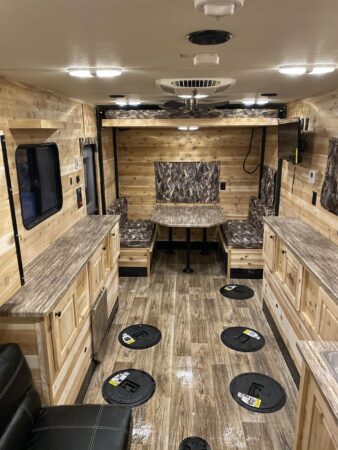
The popular interior design is wood paneling. Before you think about that 1970s version in older houses, this is cedar or oak strips that are bright and clear-coated. You’ll feel like you’re in that cabin in the backwoods, away from the things of man. Unless the neighbors are very loud, you’ll have your own quiet space.
Unless you’re on the ice on a Sunday, in that case, you can turn the LED TV on and pipe the game through the built-in sound system. No matter if you’re a Viking, Packer, Lion, or whoever you owe your allegiance to, you can catch all of the action. Before you yell at the ref, ask yourself this, is it worth scaring the fish?
Whether you go down to the RV dealer or order your customized unit direct from the manufacturer, you’ll find that the optional features line up with current, typical RV features. Here are some of the more common optional features people order:
- Heated holding tanks
- Custom exterior wraps
- Air conditioners for all-season usage
- Remote-controlled wheel lifts and awnings
- Full kitchen packages
- Full bathroom features
- Satellite and/or internet packages
- Upgraded fish house furniture
- Deluxe interior design features
- Additional sleeping space
- LED faux fireplace with 5,000 BTU heater
- Solar panel package
- Wheelchair door access
- Outdoor propane quick connect for a barbecue

How Thick Does Ice Have to be for a Fish House?
The average weight of most fish house RVs sit around 5,500 pounds. Yet they can range from 900 to 10,000 pounds. The weight of a Ford F-350 ranges from 5,878-7,737 pounds. If we round up the heaviest version of the pickup truck (most likely a dually) to use simple numbers, that comes out to be 7,800 pounds.
According to ice thickness weather experts, our example F-350 would be safe on ice that’s between 12-15 inches thick. At 12-inches, ice can hold over seven tons (14,000 pounds). Most ice anglers feel comfortable heading out on the ice when it’s at least 15-inches. Being close together, all of the activity on the surface, and accounting for sun exposure gives them a buffer as the top layer melts and reforms overnight.
When you apply for your ice fishing license with the Federal Fish and Game Service or your state’s wildlife conservation department, make sure you pick up their information booklet on the ice fishing laws in your area. If there are problems with ice damage, melting, or other issues, they will close the lake or river for safety.
Types of Fish House RVs
Since ice fish house manufacturers draw inspiration from traditional brands, this sector’s evolution has quickly innovated with primary market features. As a result, Fish house RVs have four sub-types to fit your budget and style. Some serve multi-purposes and are great all year round. During the camping season, you can take your RV edition ice house out to capture that 12-point buck on camera or to take home. Toy haulers with rear loading ramps allow you to bring your motorized adventure toys to the best trails during the summer and your snowmobile on those fresh powder days.
Skid House
Skid houses, also referred to as ice shacks, are aluminum or wooden structures with ski-like slats on the bottom. The two or three skids stretch beyond the structure’s length and have a slight curve upward to prevent digging into snow, ice, or dirt when dragged into place by a motorized vehicle.
Skid houses are the most basic of fish houses and have an ultra-lightweight, usually under 1,000 pounds. You can find them in either a box-shape or a pointed front end with the bare minimum features. Manufacturers may offer RV features like insulation, furniture, or other creature comforts as options. Otherwise, you can customize your skid house yourself. Check out Do It Yourself RV for some crossover inspiration.
Even though they lack the typical comforts of RV life, they’re very affordable and excellent on ice between 10-12 inches thick. Many will use an ATV or snowmobile as a dragging vehicle. These units come in either 6.5 or 8-foot widths, so skid houses are well suited for river ice fishing.
Standard Size Fish House RVs
If you have a conversation with someone and talk about the best ice fishing wheelhouses, they’re talking about modern fish house RVs. Standard size fish houses stretch between 12-16 feet in length. Widths, like skid houses, are either 6.5 or 8 feet. As you compare floorplans, you’ll see the standard features added gradually.
When you position your wheelhouse on the ice, a mechanism lowers the trailer’s bottom to the ice by pulling the axles up into the trailer. This action allows the trailer to create a seal around the ice, so wind or other outside elements can’t come up underneath the RV through your ice hole ports. The axles use either manual cranks, hydraulics, or electric motors. High-end models or optional features allow you to adjust the axles through wireless remotes.
If you have a quarter-ton truck like the Chevrolet Colorado (max tow 7,000 pounds), you’ll be okay to tow most of these since their gross vehicle weight rating (GVWR) is between 5,000-6,000 pounds. Make sure you account for passenger weight and save enough horsepower for driving.
Luxury Edition Fish House
In the traditional RV Community, we don’t emphasize the “mine is bigger than yours” mentality, but it inevitably happens. It’s difficult to determine who makes the best ice fish house when you look at the fish house RV editions because of the size, features, and customizations the manufacturers offer.
These top-end 25-30 foot rolling luxury cabins have a GVWR of around 10,000 pounds or more. You’ll have full kitchens, bathrooms, plenty of sleeping space, and some of the best entertainment technology on the market. Of course, there are ice fishing holes with LED lights and underwater camera pre wiring too.
Toy Hauler Fish House
Some ice anglers like to bring their adventure toys with them. Maybe you want to take your auger and rod with you to drill some test holes in other parts of the lake. Strap them to your ATV or snowmobile, open the rear hatch of your toy hauler fish house, and go exploring. Toy hauler ice fishing trailers come in standard or luxury versions. Many of them have dinettes that fold against the sidewalls and power bunks that drop from the ceiling. When towing a toy hauler, you’ll want to use a half-ton pickup truck or full-size SUV due to the weight of the adventure toy. Also, crank up that 40,000 BTU heater because once you open that rear hatch, the hot air inside your coach is going to rush out.
Ridgeline Skid Houses
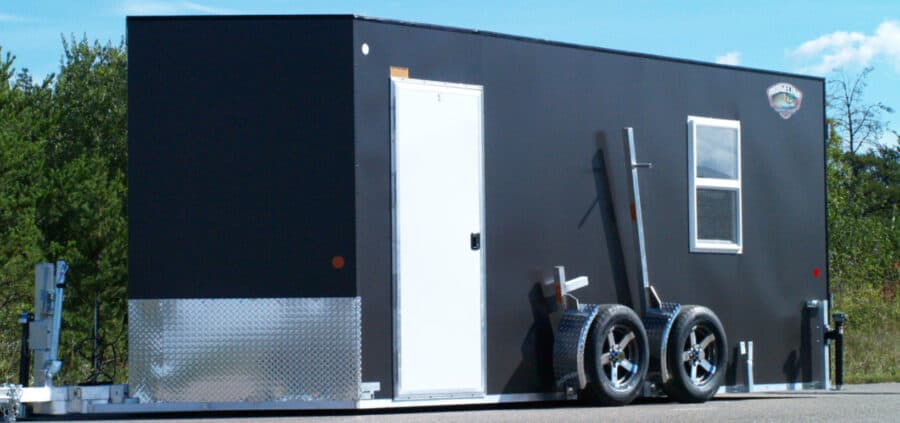
- Category: Skid House
- Length: 10-12 Feet
- Dry Weight: 775-850 Pounds
- Insulation: Thermopane windows
- Fishing Holes: Custom
- Sleep: Up to 4
If you’re looking to catch that prize-winning Walleye at Lake Mille Lacs (French for Thousand Lakes), and you’re on State Highway 210, take a few minutes to check out North Pillager near County Road 1. Here you’ll find the headquarters of Ridgeline Manufacturing. Since 2007, their boats and travel trailers have put this small town on the map.
Ridgeline’s skid houses come in lengths from 8-12 feet and either 6.5 or 8-foot widths. Their aerodynamic pointed front ends make them fuel-efficient when you’re towing them to the lake. You can choose between the rear-entry door or side entrance with the toy hauler ramp.
On a busy morning at the lake, you don’t have to wait in line at the boat launch to take your skid house onto the ice. Once you park your Chevy Blazer, you can release the skid house from its trailer and pull your ATV out from the double rear-entry doors. With a set of chains, your ATV easily pulls your skid house into position.
After you unfold the optional sidewall sofas and crank up the portable heater, you’re ready to start fishing. To avoid fuel runs, 100 or 200-watt roof solar panels can keep your solar generator going. High powered electric drills with auger bits are all you need to open your ice holes, and electric heaters require little energy.
Ice Forts Black Hole Ice Shack
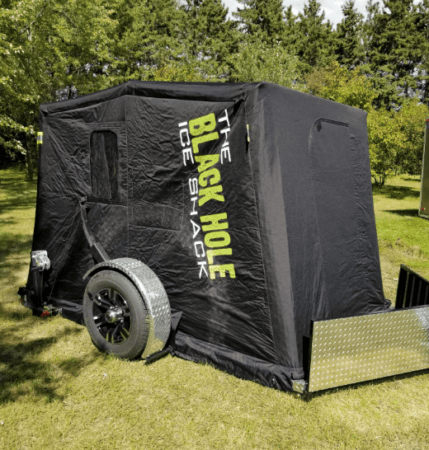
- Category: Soft Shell
- Length: 10-14 Feet
- Weight: 900 Pounds
- Insulation: Insulated Canvas
- Fishing Holes: 5
- Sleep: 2
(Brainerd- Mississippi River, Gilbert Lake, Rice Lake)
As you continue east on State Highway 210, you’ll come across one of the largest cities in northern Minnesota. Brainerd gained its popularity as a port town since it sits on the Mighty Mississippi and was a stop for the railroad. For outdoor enthusiasts, it’s the supply hub and gateway to everywhere in the geographic region.
If you’re looking for the best ice fishing shanty that’s softshell and has multiple uses, stop in at Ice Forts while you’re in Brainerd. The Black Hole Ice Shack is an insulated canvas tent structure that sets up on a drop axle frame. The tent comes in either the standard solid black or the camo hunt/fish exteriors. The flooring uses Intelli-Core material, has six ice hole ports and boot covers.
When you’re not using the ice shack, the flat cargo trailer has heavy-duty tie-downs for utility use. The Black Hole trailer comes in 10, 12, or 14 feet lengths. It has a winch, and you can remove the rock guard for oversized cargo. The trailer has an axle weight rating of 3,500 pounds.
Ice Castle Fish House Little Jigger
- Category: Standard
- Length: 12 Feet
- Dry/ GVWR Weight: 1,920/ 4,000 Pounds
- Insulation: Fiberglass Batt
- Fishing Holes: 4
- Sleep: 2
Lac Qui Parle State Park (French: Talking Lake) is home to Walleye, Northern Pike, and the Ice Castle Classic Ice Fishing Tournament. The competition takes place in early February and awards prizes to the top 50 best catches. Participants aren’t allowed on the lake before 8 a.m. on the day of the event, so if you get there early, swing by the sponsor’s location. Since 1997, Montevideo, Minnesota, is where Ice Castel Fish Houses builds their wheelhouses.
The Little Jigger is Ice Castle’s top-selling standard size fish house RV. Once you manually crank the axles up, the four-holed floor forms a reliable seal against the ice. The wheelhouse’s aerodynamic nose places the entry door on the passenger-side and twin propane tanks (with a hardshell cover) on the drivers-side.
Inside, you can relax on the full-length convertible sofa along the main driver-side wall. Above the fishing holes, it’s pre-wired to connect to whatever size LED TV you mount. The stereo above the sofa shares its speakers with the TV, but remember, those explosions on your action flicks could scare off the fish. The kitchenette that shares the wall with the propane bottles comes with a 20,000 BTU furnace, a two-burner stove, and enough counter space to work. All of this comes together with carpeting, cedar trim, and interior walls that hide the fiberglass batt cocoon that protects you from every angle.
Forest River Grey Wolf Fish House
- Category: Big Four Standard, Toy Hauler, Luxury
- Length: 25.6-32.2 Feet
- Dry Weight: 3,418-6,338 Pounds
- GVWR Weight: 5,476-9,855 Pounds
- Insulation: Rigid foam in sidewalls and subfloor with bubble wrap insulation
- Fishing Holes: 8
- Sleep: 4
If you need that ice fishing “fix” during the off-season, why not plan a trip to Topeka, Indiana. The city rests on the eastern outskirts of the RV Capital of the World. Here you’ll find the only factory owned by one of the Big Four RV parent companies that produce fish house coaches. Cherokee RV, a division of Forest River Inc., offers six floorplans in its Grey Wolf Fish House models. The public can take tours on Tuesdays and Thursdays (the company allows pictures, but not video. Amish workers may not want to have their photo taken due to religious beliefs).
You’ll find the same excellent quality construction and innovative features seen in the traditional Cherokee Grey Wolf, with the best wheelhouse features. Regardless of the size, each model comes with eight-floor ports perfectly positioned throughout the floor. The rear of the RV comes with a U-shaped dinette that converts to a big queen bed. The toy hauler and large 21GP have electronic queen bunks that lift to the ceiling when they’re not needed.
Every unit, no matter the size, has a water closet in the front nose space. The coaches also have kitchen countertops with stoves with three-burners. The plumbing works as follows:
- 16BF & 16GR: Cassette toilet with a 5-gallon capacity
- 17BB, 17MP, & 17TH: Heated 15-gallon fresh water/heated 12-gallon grey water for the kitchen sink and shower/ heated 4.5-gallon black water for the commode
- 21GP: Heated 15-gallon fresh water/ combined heated 23-gallon grey-black tank for the kitchen sink, shower, and commode
Another standard feature is long, narrow trunk cabinets for fishing rod storage. The 17 and 21 level models add seating cushions on the lid. Electronic features include multimedia systems, TV pre-wiring/wall reinforcement, LED lighting around the fishing holes, and pre-wiring for an underwater camera. For all-season usage, an awning is optional but standard on the 17TH and 21 GP.
Yetti Outdoors Traxx Edition T612-DK
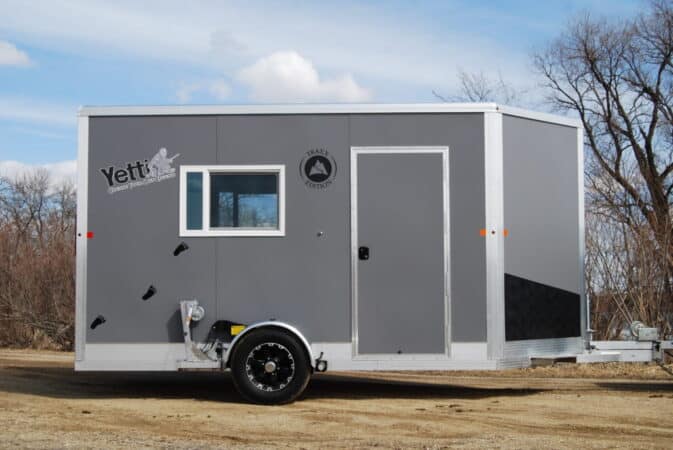
- Category: Standard Toy Hauler
- Length: 12 Feet
- Dry/ GVWR Weight: 2,475/ 4,300 Pounds
- Insulation: R-7 Rigid foam board with anti-condensation foam insulating tape
- Fishing Holes: 5
- Sleep: 3
According to fishing reports, Whiskey Lake in Douglas County, Minnesota, is an excellent lake for Black Bullhead, Black Crappie, and Yellow Perch. If you’ve ever caught bluegill, you know why you need a strong glove to protect your hands to avoid their sharp spines. Don’t feel too bad as you’re frying them up in your pan; those spikes really hurt.
Before you get to the lake, stop in the city of Brandon to load up on bait and supplies. You’ll also find Yetti Outdoors. This fish house RV company takes full advantage of the all-season capabilities of these units. Yetti Outdoors has four editions you can choose: Angler, Grand Escape, Traxx, and Shell/Customs. The Traxx Edition is their toy hauler models. The T612-DX is a standard size model with a fold-up sofa on the passenger-side. The company places the kitchenette in the nose section, giving you the most space for your motorized adventure toy. The finished modern wood-paneled interior gives you a comfortable living space as you ice fish from one of the five floor ports.
To make your ice fish house stand out from the rest of the shantytown neighborhood, there are many colors and features to choose from for the exterior. Once the season’s over, make sure you winterize your fish house RV so that you can prepare for the fall hunting season.
ALUMAICE 824TAH- Tandem Axle

- Category: Luxury
- Length: 24 Feet
- Dry/ GVWR Weight: 7,000/10,000 Pounds
- Insulation: Spray Foam
- Fishing Holes: 7
- Sleep: Up to 6
The fishing opportunities in Southern Minnesota is outstanding. Due to the high nutrition in the lakes and rivers, walleye, perch, and other game fish grow to prize-winning sizes quickly. About an hour and a half southwest of Minneapolis is Mankato. This small city of 40,000 is the nexus to many of the best rivers and lakes that Minnesota’s southern region offers.
You’ll also find AlumaIce, the makers of premium ice fish house RVs. Most fish house RV manufacturers save the best features for the 30-foot luxury units. Optional features become standard, and the interior design looks more RV than ice house. AlumaIce doesn’t subscribe to that idea. Their standard fish house models are as luxurious as their full-length versions.
AlumaIce’s 824TAH tandem Axle is the flagship of the fleet. With a push of a button on the wireless remote, the hydraulic axles lower the 30-amp wheelhouse into place. Between the three dual-pane windows, LED ambient lighting, and primary low-profile interior lights, you’ll find the luxury cabin design perfect for your outdoor and ice fishing adventures.
All you need to fire up your mobile ice palace is a portable generator that allows you to plug the shore power cable. The dual propane bottles power the 40k BTU furnace and the three-burner stove. While you and your friends fish from the seven portholes, you can enjoy the complete entertainment center with the 32-inch LED TV, stereo, and multi-input connections. Be careful who you invite; otherwise, you’ll be so busy showing your luxury fish house to the entire shantytown, you won’t have time to go after that prize-winning walleye.
Glacier 24TH RV Explorer Toy Hauler
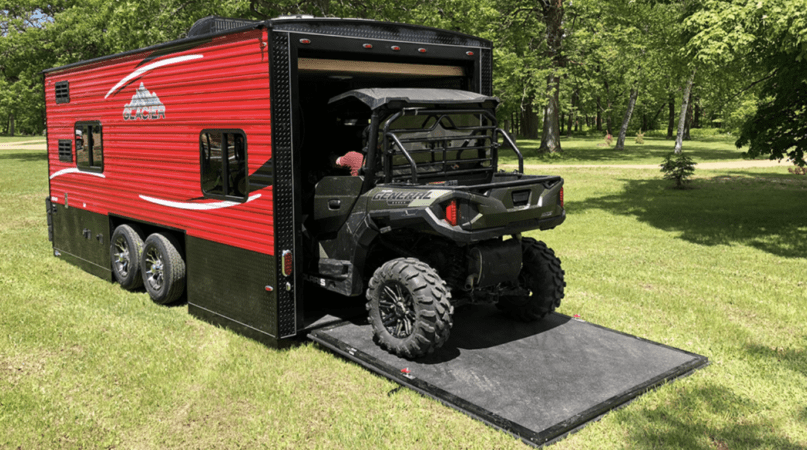
- Category: Luxury Toy Hauler
- Length: 24 Feet
- Dry/GVWR Weight: 6,820/ 10,000 Pounds
- R-Value: R-16 Insulation
- Fishing Holes: 7
- Sleep: 6
Northwest Minnesota is home to Lake Bemidji. This 76-foot deep lake is known for Rock Bass, Muskellunge, Largemouth Bass, and Northern Pike. Once the ice sets to around 15 inches on Lake Bemidji, checkout Glacier Ice House’s Luxury 24th Explorer Toy Hauler since you’re out that way.
This luxury seven-seater (four-person sleeper) has a fishing hole for each seat and a full plumbed bathroom. The full kitchen with a refrigerator has everything you need to keep everyone fed during those long weekends. The glacier fish house has tandem axles and an extended garage so that you can bring two snowmobiles with you. The RV is too heavy to tow with them, but whether you use your adventure toys to go back and forth for supplies or hit the trails, it’s always great to go together.
Glacier gives you options when it comes to furniture. You can choose from an L-shaped sofa, a standard sofa with a hide-a-way bed, or a convertible four-person dinette. The toy haulers come with roll-over sofas that fold against the sidewall at the coach’s rear and a fold-out couch opposite the kitchen. Swapping out the couch with your furniture preference isn’t much of a problem. When you tour their sales lot, they may have a layout already ready and waiting for you.
How to Get Started Ice Fishing
Some friends of the Camper Smarts website are avid anglers in Florida. As the U.S. gets a better handle on the COVID-19 Pandemic, they asked us about planning a trip up to Minnesota to try their hand at ice fishing. Being a transplanted Floridian ourselves (originally from the Detroit area), we had to think about how we would best advise them (hence the inspiration of this discussion).
Our advice is multi-stepped. Since the group of friends plans on driving up, the first step is to hop on the Outdoorsey website and look into renting a fish house RV near their destination point. To test this idea, we conducted our search. Without narrowing down the criteria, three listings on the first page showed wheelhouse RVs. When you’re negotiating the rental contract, see if the renter has additional features. If they include their auger to drill ice holes and some ice fishing rods, that extra cost could save you money instead of buying them yourself. The renter may even point you in the right direction on where to buy your lures and other fishing equipment.
Another piece of advice is to buy your winter wear up there. Florida’s version of winter apparel isn’t appropriate for the subzero temperatures of Minnesota. You’ll need heavy parkas, long underwear, and other winter outerwear to survive up there. Floridians have adapted to three-figure summer temperatures, not negative number winters.
Finally, keep up with Camper Smarts and RV LIFE to learn the many tips and tricks of the RV lifestyle that crossover between traditional RVs and fish house RVs. Ensure you have the correct fishing license and talk to as many people as you can on the lake. Be careful not to touch any of the humorous wards hanging from other fish houses and avoid getting blamed for scaring off the fish.
About the Author
Although he’s from Motown, Brian is a legacy RVer that grew up on I-75. He, his wife, and three working-class fur-babies have enjoyed the full-time RV lifestyle since 2017. Like John Madden, he hasn’t “worked” in years because he gets to write about his passion. When he’s not working, he supports his daughter’s dog rescue efforts and disability causes. Learn more with him on Camper Smarts.



